
Atlas F1 Technical Writer
The third round of the 2004 season had the least number of retirements in quite a few years, but also the most number of replaced engines since the new engine rule was introduced. The teams also had to contend with a new track none have raced on before, as well as weather and other elements of surprise. Craig Scarborough reviews the cars and the technical changes seen through the weekend
While most teams found their way at the new circuit, the McLaren cars self destructed in their worst weekend in many years. Following this race all of the teams finally returned to Europe to plan their mid season assault on Ferrari.
As the teams had only had the FIA supplied track layout their thousands of simulated laps were all that they could use to predict the car set up for the new circuit. Despite some aspersions being cast on the accuracy of the map, in comparison to the detail data the teams collect from other circuit from GPS systems, the predictions were fairly accurate and no team arrived with a set up too far astray from what was required.
Teams and drivers did have to ascertain how aggressive the kerbs were, how the banked corners worked, and how the track surface would yield grip. As far as the kerbs went the drivers were able to ride them quite well without problems, having only to being careful not to over the hard kerbs and end up on the compacted sand on the outside of the track.
The softer outer surface brought several problems; first of all when a car ran over the kerbs it brought all sorts of debris back on track, and secondly the car would ride on its belly along the kerb, as it doesn't have the ride height to maintain ground/wheel contact as the sandy run off was lower than the kerb/track height. This caught out Sato in the race, wrecking his front wing.
No drivers found any challenging corners to praise, and the hairpins were tighter than first imagined. Otherwise the layout provided no problems, and the sequencing of fast/slow and left/right corners provided some overtaking opportunities.
The forethought that wet into the tracks surface and the controls to stop sand blowing on the track appeared to work; most drivers were pleased with the level of grip, which of course improved as the weekend wore on and rubber was laid down. Offline was trickier, and by race end the cars needed to remain on line in order to keep the tyres clean and in contact with the better track surface. This effect is seen at most circuits, but was especially bad here.
As the race weekend wore on the lead in the tyre war switched; as the track rubbered in Michelin tyres seemed the favourite after Bridgestone were on top on the clean Friday track. Cooler track temps in the race were believed to go in favour of Ferrari's Bridgestones, a fact not borne out of the comparative competitiveness of the Japanese suppliers customer teams.
One aside from the tyre's comparative competitiveness was the string of Michelin tyre failures; in the opening Friday sessions, Alonso, Coulthard and Davidson all had tyre failures. Fortunately these were not attributed to a fault in the tyre leading to delamination as first thought, but instead to the drains installed on the track side to the kerbs had sharp edges and were cutting the tyres.
The offending drains were removed and cemented over, causing fears of standing water when rain fell on Sunday. It remains odd that Michelin runners were singled out for this problem, suggesting the Michelin tyre carcass it thinner between thread and sidewall than Bridgestones.
Sand was a concern for the teams from a mechanical point of view as well as grip. Sand getting into the engines was a primary concern, and a relatively simple one to solve. Air filters inside the airbox were up-rated, with pleats twice as deep to absorb more contaminants and still flow enough air to feed the engine. But the sand in the air could also find its way into the gearbox and electronics when the cars were running or being serviced. BAR used plastic covers for the front of the gearboxes when they were being serviced.
High ambient and track temperatures were foreseen by all teams; around 30-dergrees air temperature and 50-degrees on the track are at the high end of the F1 scale, and the cars ran lots of cooling outlets to cope. A head wind on the two opening days was turned to a strong tail wind on race day, upsetting the cars balance, and gusting side winds made cornering unpredictable. But the storm clouds of Sunday had passed by race start and didn't produce the rain that threatened, and far from being predicted before the race weekend.
Race strategy lead to a triple stop being the preferred solution, as high fuel consumption demanded a lot of fuel over the entire race, but brake fears deterred heavy fuel loads.
Team by Team
Ferrari
This year the Schuberthe helmet uses a permanent attachment to HANS device; whereas other helmets use removable metal fasteners, the Schuberthe permanently fixes the strap to the helmet, saving a crucial few grammes of weight and further improving driver comfort through the easing of the loads passed through the drivers neck in corners.
Another neat integration is the connections for the radio being hidden by a small aerodynamic cover on the right side of the helmet. Michael Schumacher's HANS device uses a lot of padding between the collar and the drivers shoulders; strangely Rubens does not use as much padding.
Friday went cleanly for the team, running at the top of the time sheets, while they second guessed how the track would bed in over the next two days. With the gripper track in Saturdays free practice sessions the team struggled; Ferrari also suffered brake problems, and they tried different caliper and disc/pad choices, but decided that the Brembo set up was the most consistent. Even if it produced a long pedal it remained trustworthy, while other formats gave less predictable results.
A tight qualifying session saw Ferrari take the front row from poor first qualifying positions, prompting speculation that low fuel was used. This proved unfounded as the team stopped at the same 9-10 lap window as their competitors. Rubens had a few issues with a rear jack problem in his first stop, a near miss in the pit lane and fading brakes in the middle stint. Michael had no reported problems and lead Rubens home to first.
Renault
Valuable track time was lost on Friday with a multitude of problems; Fernando Alonso with tyre failure and hydraulic problem and Jarno Trulli stopping out on the circuit with a fuel system problem leading to a small fire. These problems limited track time, but fortunately did not cost Jarno 10 grid places when the team were able to repair his engine.
Qualifying ended up well, despite Trulli suffering brake problems and Alonso locking up and sliding wide in the first and last turns. Fernando lost out at the start when he lost part of his front wing and had to pit for a new one. Then drivers ran strong races, with Jarno losing grip and a place towards the end of the race and Fernando making up for his extra pitstop.
Williams
Allied to this were two element winglets on the sidepods and the large exhaust fairing fitted for qualifying and the race. Work done by BMW in Stuttgart discovered the engine damage to Ralf's car in Malaysia was due to a faulty component, which would be reengineered.
Friday's sessions were tidy, and the team suffered few of the problems seen elsewhere. Tyre choice went the way of the harder compound, which still provided the grip to take the top two positions in qualifying 1, but errors cost time in qualifying 2. At the race start, A clean launch were enough to keep Juan Pablo in position while Ralf lost out to Sato.
The later incident with Takuma Sato saw Ralf Schumacher's car land heavily on its outer wheels; it was surprising this didn't cause any damage, despite Schumacher believing there was a problem as he returned to the pits. His race also saw a pit lane incident with his mechanics, but a reliable run to the flag. Juan Pablo Montoya's simple run all the way through to 8th a few laps from the end, on top of brake problems, meant he started to lose gears and then hydraulic problems interfered with the throttle as well. He slipped back rapidly to finish thirteenth, having been third.
BAR
Running a similar set up to Malaysia, BAR had learnt their lessons about running Michelin and Alcon brakes in hot weather, and arrived in Bahrain with a set up based on that data and simulations.
While the race drivers did their laps, third driver Anthony Davidson made the most of his running to evaluate tyres on longer runs. This work is a real advantage to BAR, as their top four competitors are not allowed to run the third car. In Saturday's free practice sessions the result could be seen; the BAR drivers were at the front of the timesheets despite a leak from Jenson Button's carbon fibre gearbox. Qualifying 1 saw more understeer on the car, dropping the drivers to 7th and 8th for qualifying 2. Conservative final runs saw the drivers take the third row.
Clean race starts saw Sato gain a position and Button hold station. Their first stint ran over to Laps 12 and 13, when Button's rear jack failed to left go of the car, dropping him back. Sato's race then took another dramatic turn when he ran wide over the kerb, impacting his floor and front wing badly. His front wing was broken in the middle and sagging at the sides, an unscheduled stop to replace it cost him more time. Button made another slow scheduled stop, and Sato ran with his rear wings gurney flap hanging off. Despite the distractions two points finishes were proof that BAR and Honda's reliability have made huge gains.
McLaren
Kimi Raikkonen's engine blew up within a few laps of the second session with a small fire inside the airbox. According to Norbert Haug, electronic problems were creating a misfire and led to the fire, not a complete engine failure. Meanwhile David Coulthard's left rear tyre punctured, leaving him out on the circuit. After no running on Friday and Raikkonen's engine needing changing, penalising him ten grid slots, their weekend was hit by brake failure for Coulthard and more engine woes for Raikkonen.
With these problems the team simply didn't have the track time to learn the circuit and gather the data to make strategy and set up calls for the race. So Raikkonen only did an out lap for his qualifying 2 session, in order to save his engine, but more importantly use less fuel, only burning a slow laps worth from his brimful tank, rather than two slow and a flying laps, in order to run as longer first stint as possible to make up for his back row start.
His woes continued as he struggled to leave the dummy grid and then struggled for pace with his fuel load; finally he once more found his race shortened to a few laps with a massive plume of smoke and flame trailing from his car as he came to the end of a straight. Coulthard ran slowly but cleanly down the order until late in the race; his engines pneumatic system failed forcing him to pit for an exploratory stop but finally killing the engine as he left the pit.
Sauber
Friday went without major incident but struggled on set up with both drivers having oversteer. Qualifying laps were untidy as usual for Felipe Massa and more controlled for Giancarlo Fisichella. As was the case in the race as both drivers had a few spins, partly due to increasing understeer and loss of confidence in the cars handling.
Jaguar
Jaguar appeared with a new aero part on the sidepods, the usual high flip up has been replaced with a proper winglet, as adopted across most of the grid, the tightly waisted sidepods create a very wide main flip up and this requires a small strut to support the aerodynamic load it creates.
Qualifying saw Webber make a “messy lap” and left the team well down the order. Both drivers had clean getaways off the grid after the problems in the first two races, and then reliable runs through the flag for both drivers drew the teams' first point in 2004 for Webber.
Toyota
Toyota once again brought an unchanged car in preparation for an aero update in Imola in three weeks. Toyota were off the pace on Friday, but bounced back to much better qualifying sessions as track conditions changed to suit them. The race saw a return the lack of grip experienced on Friday, but see two races finish frustratingly just out of the points.
Jordan
Appearing with less cooling area compared to Malaysia, but the Jordan's were otherwise unchanged. Friday saw Nick Heidfeld stopped out on the circuit with an engine problem, later necessitating an engine change. Qualifying saw the driver suffering with increasing oversteer and rear grip. Both drivers struggled in the race with varying handling returning to understeer, as well as brake problems and a small hydraulic leak to Giorgio Pantano.
Minardi
As with Malaysia, Minardi ran the huge funnel-like chimneys with the small flip up attached. A general lack of grip kept the team at the rear of the grid, aside from the two drivers penalized for engine swaps. The race started badly for Gianmaria Bruni, who failed to leave the grid and was then re-started in the pit lane, and he struggled throughout the race and did post a reliable finish. Zsolt Baumgartner was stricken by an electronic problem that eventually lead to his retirement.
Arriving at the untested Bahrain circuit the teams had more to cope with than at a normal race. They did not have the historic data to plan their set up, plus they had high temperatures, sand and a changing track surface to cope with.
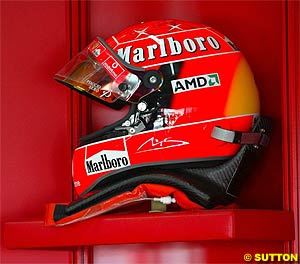 Ferrari appeared with a visually unchanged car, and from the start of the weekend were on the pace. One non-car development was the appearance of the new Schuberth helmet for both Ferrari drivers. Every year, the German manufacturer develops a revised helmet in conjunction with Ferrari. Such is the close relationship between Ferrari and Schuberthe that wind tunnel tests at Schuberthe use a mock up of the Ferrari cockpit. Improving driver comfort from reduced buffeting and lift at high speeds, the shape also improves airflow around the cockpit and into the air inlet above the drivers head.
Ferrari appeared with a visually unchanged car, and from the start of the weekend were on the pace. One non-car development was the appearance of the new Schuberth helmet for both Ferrari drivers. Every year, the German manufacturer develops a revised helmet in conjunction with Ferrari. Such is the close relationship between Ferrari and Schuberthe that wind tunnel tests at Schuberthe use a mock up of the Ferrari cockpit. Improving driver comfort from reduced buffeting and lift at high speeds, the shape also improves airflow around the cockpit and into the air inlet above the drivers head.
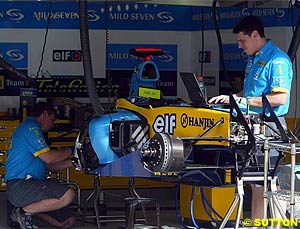 As with Malaysia Renault ran a range of sidepod openings, including the huge chimney which at its roots overlaps the other cooling orifices. Interestingly the innovative book folded radiators on the right hand sidepod are not mirrored on the left, which sees a flat cooler placed at a compound angle (as with Ferrari).
As with Malaysia Renault ran a range of sidepod openings, including the huge chimney which at its roots overlaps the other cooling orifices. Interestingly the innovative book folded radiators on the right hand sidepod are not mirrored on the left, which sees a flat cooler placed at a compound angle (as with Ferrari).
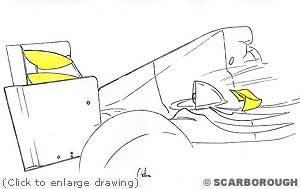 Various new tweaks appeared on the cars for Bahrain, most notably was the first copy of BAR's rear wing fences. Williams's rear wing is similar in philosophy, as Williams and the fences act to separate the differing pressure regions between the inner and outer wing sections, keeping the middle section efficient without feeding too much vortex (and drag) inducing pressure to the outer sections.
Various new tweaks appeared on the cars for Bahrain, most notably was the first copy of BAR's rear wing fences. Williams's rear wing is similar in philosophy, as Williams and the fences act to separate the differing pressure regions between the inner and outer wing sections, keeping the middle section efficient without feeding too much vortex (and drag) inducing pressure to the outer sections.
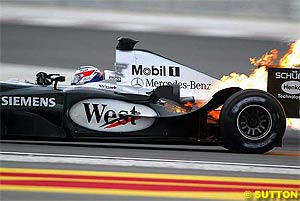 McLaren's major upgrade will not even due for Imola, but rather the team will wait for a month until the Spanish GP. This must be a painful time for the team, who have had one of their worst weekends in recent memory.
McLaren's major upgrade will not even due for Imola, but rather the team will wait for a month until the Spanish GP. This must be a painful time for the team, who have had one of their worst weekends in recent memory.
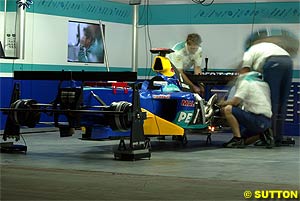 Their split radiator layout (one conventional angled and one book-folded as with Renault) required much more open sidepods than even Malaysia required. The more thermally stressed oil and water coolers in the left hand sidepod saw a few blades removed from the outlet grills to improve the out flow. Otherwise Sauber ran new but imperceptible developments borne from their new wind tunnel.
Their split radiator layout (one conventional angled and one book-folded as with Renault) required much more open sidepods than even Malaysia required. The more thermally stressed oil and water coolers in the left hand sidepod saw a few blades removed from the outlet grills to improve the out flow. Otherwise Sauber ran new but imperceptible developments borne from their new wind tunnel.
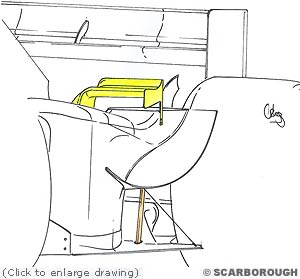 Hitting the ground running on Friday the drivers were towards the front of the timesheets, despite leak for the third car and some balance problems for the race drivers. The team maintained their relative pace but was struggling in getting the power down in through out the later part of the weekend.
Hitting the ground running on Friday the drivers were towards the front of the timesheets, despite leak for the third car and some balance problems for the race drivers. The team maintained their relative pace but was struggling in getting the power down in through out the later part of the weekend.
|
Contact the Author Contact the Editor |
Please Contact Us for permission to republish this or any other material from Atlas F1.
|
Volume 10, Issue 14
Atlas F1 Exclusive
Interview with Juan Pablo Montoya
All the King's Men
Bjorn Wirdheim: Going Places
Ann Bradshaw: Point of View
2004 Bahrain GP Review
2004 Bahrain GP Review
Bahrain GP: Technical Review
"Bloody Mess, Really..."
Same Same... But Different
Stats Center
Qualifying Differentials
SuperStats
Charts Center
Columns
The F1 Insider
Season Strokes
On the Road
Elsewhere in Racing
The Weekly Grapevine
> Homepage |